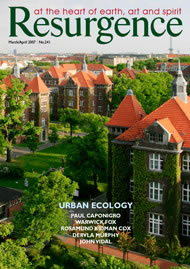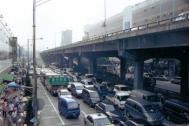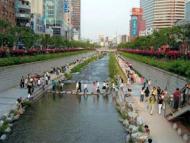SEOUL, THE CAPITAL of Korea, is the seventh largest city in the world. Its older inhabitants still remember playing and washing their clothes in the river Cheonggyecheon – a wide seasonal stream that used to divide the city. That was before the river was progressively ‘urbanised’: a sorry tale of increasing pollution and canalisation, leading to the final insult of being concreted over entirely. To finish the job, in the 1970s, an elevated six-lane motorway was built above it.
There aren’t many ‘happily ever after’ stories when it comes to urban rivers, but here follows an astounding tale of ecological rehabilitation.
In 2002, the mayor, Lee Myung-bak, pledged to restore the river by tearing down the motorway and creating a five-mile-long, 800-yard-wide, 1,000-acre lateral park snaking through the city. The revolutionary concept was to consider removing a road that carried 160,000 cars a day and that, although perpetually jammed, was still considered indispensable to the city’s economy.
After extensive planning and consultation, the population of Seoul gave the go-ahead for the project. The real opposition came from the urban planners who were sceptical about the prediction that taking away roads might actually improve congestion.
It had taken twenty years to build the roads, but it took just two to pull them down and restore the river. In the meantime, the city invested in its bus services and gave people options to avoid the motorway. The result, according to one expert involved in the project, was that “the cars just disappeared, drivers changed their habits … some of them gave up their cars and others just found different routes.”
Changes in the city’s environment were profound, as the restored river acts as a natural air-conditioner, cooling the capital during its long, hot summers (average wind speeds are up to 50% higher than before the restoration). There are twenty-two new bridges, as well as waterfalls, running tracks, and, of course, many more birds, fish, insects and plants. It is estimated that 30,000 people use the riverside park every weekend. Such is the success of this radical restoration that other cities in East Asia, such as Shanghai and Tokyo, are taking an interest.
This is an edited excerpt from an article in The Guardian.








